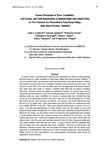Farmer Perceptions of Water Availability, Soil Erosion, and Yield Relationships in Rainfed Paddy and Upland Fields on Two Transects in a Watershed in Nong Saeng Village, Khon Kaen Province, Thailand
JIRCAS Journal
| ISSN | 13407686 |
|---|---|
| 書誌レコードID(総合目録DB) | AA11030483 |

本文フルテキスト
jircas_journal10-_31-41.pdf1.66 MB
A transect survey was conducted to assess farmers' perceptions of effects of Water shortages, and soil erosion in a small watershed in Nong Saeng village, Khon Kaen Province, Thailand. A map of watershed fields was presented to 24 watershed farmers, who placed transect 1 midway and transect 2 near the head of the watershed. Transects were surveyed over three days. The transects covered 25% of the crop area (83% sticky rice and sugarcane) of 10 transect farmers. Rice yields were more stable on transect 1 (stability index 0.32) than on transect 2 (stability index 0.11). Normal or better rice yields were obtained on transect 1 in nearly 3 years out of 5, and failures occurred less than 1 year out of 10 (35 plot-seasons over 5 years). The primary factor affecting yields was water availability. On transect 2, normal yields were obtained less than 1 year out of 10, and failures occurred more than 4 years out of 5 (19 plot-seasons over 5 years). Soil erosion was the main reason for crop failures. On transect 1, soil erosion affected less than 5% area in 5 of 7 paddy plots. Three plots lacked water for 3-6 weeks, but supplemental water was available 50%-67% of the time. These plots obtained yields normal or greater 2 out of 5 years. Two plots had approximately 12 weeks without water, but the number of years with normal or better yields increased from 2 to 4 when pond water availability increased from 25% to 50% of the dry weeks. In a plot without water for 5 weeks but with supplemental water available in all dry weeks, yields that were normal or greater were obtained 4 out of 5 years. In a plot without pond water for 8 weeks and complete lack of access to pond water, normal yield was achieved only 1 out of 5 years, and crop failure occurred 3 out of 5 years. Sugarcane yields were more stable (stability index 0.56) than rice yields. A range of factors affected sugarcane yield, and soil erosion was more important than water availability. Research on pond number and placement, reduction of pond water loss, wet season soil erosion control, and dry season water application is recommended for improvement of small watershed productivity and sustainability. Similar surveys in other representative soil type-topography combinations could extend the applicability of these methods.
| 刊行年月日 | |
|---|---|
| 作成者 | John S. CALDWELL Somsak SUKCHAN Wimonrat On-ok Chumporn SATRAVAHA Chikara OGURA Yukiyo YAMAMOTO Prapatsorm PRAPIN |
| 著者キーワード | farm ponds rice stability sugarcane |
| 公開者 | Japan International Research Center for Agricultural Sciences |
| オンライン掲載日 | |
| 国立情報学研究所メタデータ主題語彙集(資源タイプ) | Journal Article |
| 巻 | 10 |
| 開始ページ | 31 |
| 終了ページ | 41 |
| 権利 | Japan International Research Center for Agricultural Sciences |
| 言語 | eng |
